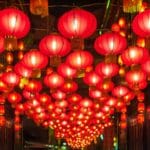Get ready to embark on a culinary adventure with our ultimate guide to tangyuan (湯圓), the beloved Chinese glutinous rice balls that are a feast for the senses. These delightful spheres hold deep cultural significance, symbolizing reunion and family, especially during festivals like the Lantern Festival. From classic sweet fillings like black sesame and peanut to savory surprises and regional variations, we’ll uncover the secrets to crafting and enjoying perfect tangyuan.
A Sweet Celebration: History & Symbolism
Tangyuan (湯圓), those delightful little glutinous rice balls, are more than just a tasty treat. They’re a symbol deeply woven into the fabric of Chinese culture, representing family, togetherness, and the cyclical nature of life. Their round shape embodies wholeness and unity, making them the perfect emblem of family reunion. This symbolism is further reinforced as the name tang yuan sounds strikingly similar to the Chinese phrase for “reunion.”
The history of tangyuan is somewhat shrouded in mystery, with various theories suggesting their origins. Some believe they emerged during the Song Dynasty, while other accounts trace them back even further. Regardless of their precise beginnings, their association with unity and harmony has solidified their place in celebratory traditions. Over time, these little spheres of joy have evolved, with different regions developing unique twists and customs. Learn more about the rich history and cultural context of these delightful rice balls. [https://www.lolaapp.com/#what-is-tangyuan-in-english]
From Dough to Delight: Crafting Tangyuan
Creating tangyuan is a rewarding experience, offering a chance to connect with tradition while indulging in a bit of culinary creativity. The process begins with the dough, a simple yet essential foundation. Glutinous rice flour, the star ingredient, is mixed with hot water to create a soft, pliable dough. Achieving the perfect consistency – not too sticky, not too dry – may take a little practice, but the results are well worth the effort.
The real fun begins with the fillings. Traditional favorites include rich and nutty black sesame paste, crunchy crushed peanuts, and subtly sweet red bean paste. But the possibilities extend far beyond these classics. Savory options, like minced pork seasoned with aromatic spices, open up a world of exciting flavor combinations. Some families even incorporate chopped vegetables, preserved fruits, or other regional specialties, creating unique family recipes passed down through generations.
Modern adaptations see inventive cooks experimenting with everything from chocolate ganache to creamy cheese fillings, constantly pushing the boundaries of what these little balls of dough can contain. For detailed recipes and step-by-step instructions, check out our guide to making perfect tangyuan at home. [https://www.lolaapp.com/#what-is-tangyuan-in-english]
Once filled, the dough is carefully pinched and rolled into smooth spheres, ready for their gentle simmer in boiling water. As they cook, they magically float to the surface, a clear sign that they are ready to be enjoyed.
Serving Tangyuan: A Feast for All Occasions
The beauty of tangyuan lies in their versatility. For a sweet treat, they are often served in a fragrant ginger syrup, the warm spice complementing the soft chewiness of the dough. A comforting bowl of sweet red bean soup offers another popular option, creating a harmonious blend of textures and flavors. Savory tangyuan, on the other hand, might be served in a light, flavorful broth, seasoned with soy sauce, a sprinkle of fresh herbs, and perhaps a drizzle of chili oil for an added kick.
Beyond festivals, tangyuan grace tables at various family gatherings. From birthdays and anniversaries to casual get-togethers, these little rice balls symbolize the warmth and connection of family bonds. Explore how tangyuan play a significant role in cultural celebrations and daily life. [https://www.lolaapp.com/#why-do-chinese-people-eat-tang-yuan]
Regional Variations: A Tapestry of Flavors
Across China, each region boasts its own cherished tangyuan traditions, showcasing local ingredients and culinary preferences. Ningbo, in Zhejiang province, is particularly renowned for its tangyuan craftsmanship. These delicate creations often feature intricate fillings and elaborate decorations, a testament to the city’s culinary artistry.
In southern China, you might encounter Cantonese-style tangyuan filled with lotus seed paste and a hint of dried shrimp, a surprising yet harmonious sweet and savory combination. Sichuan, famous for its bold, fiery flavors, might spice things up with fillings of pork and a generous dose of chili oil.
| Region | Characteristics |
|---|---|
| Ningbo | Intricate fillings, exquisite craftsmanship, often larger in size. |
| Sichuan | Spicy and savory fillings, often featuring chili oil and pork. |
| Jiangsu | Sweet fillings, sometimes incorporating fragrant osmanthus flowers. |
| Guangdong | Cantonese-style, can include sweet and savory elements like lotus seed paste and dried shrimp. |
| Other Regions | Numerous variations exist, showcasing local ingredients and preferences. |
These are but a few examples, and the world of tangyuan is constantly evolving. Ongoing research and culinary innovation suggest that there are likely many more regional variations waiting to be discovered.
Tangyuan in the Modern World
While steeped in tradition, tangyuan continue to evolve in the modern culinary landscape. Innovative chefs are experimenting with new flavors, textures, and presentations, pushing the boundaries of this classic dish. From unique fillings like durian and salted egg yolk to modern cooking techniques like molecular gastronomy, tangyuan are being reimagined for a new generation.
This culinary evolution also extends to healthier versions of tangyuan. With growing awareness of health and dietary needs, some recipes incorporate whole-wheat flour for added fiber or utilize alternative sweeteners. Creative fillings featuring fresh fruit, nuts, or lean protein offer lighter, more nutritious options. For a deeper dive into the nutritional aspects of tangyuan and tips for healthier choices, be sure to check out our article on tangyuan and health. [https://www.lolaapp.com/#is-tang-yuan-unhealthy]
Tangyuan vs. Yuanxiao: Unraveling the Mystery
While often used interchangeably, the terms “tangyuan” and “yuanxiao” refer to slightly different preparations of these glutinous rice balls. Tangyuan, predominantly enjoyed in southern China, are made by shaping the dough around the filling, much like crafting miniature dumplings.
Yuanxiao, more common in northern China, are created by rolling small balls of filling in a tray of dry glutinous rice flour until they are coated and round. This distinction in preparation method leads to subtle textural differences. Tangyuan tend to have a smoother, chewier texture, while yuanxiao have a slightly rougher exterior and a denser feel. Explore the subtle yet fascinating distinctions between tangyuan and yuanxiao. [https://www.lolaapp.com/#what-is-tangyuan-in-english]
Conclusion: A Timeless Treat
Tangyuan represent more than just a delicious food; they embody a connection to history, family, and the changing seasons. Whether you’re savoring a traditional bowl during a festival, experimenting with modern flavors in your own kitchen, or exploring the regional variations across China, each bite is a celebration of culture and culinary creativity. So gather your ingredients, roll up your sleeves, and embark on your own tangyuan adventure.
And for those seeking other culinary adventures, why not explore the diverse noodle dishes at Talde Noodle Bar in Brooklyn or the handmade Chinese noodles at Tam’s Noodle House in San Francisco?
- Unlock Water’s Symbolism: A Cross-Cultural Exploration - April 20, 2025
- Identify Black and White Snakes: Venomous or Harmless? - April 20, 2025
- Unlocking Potential: Origins High School’s NYC Story - April 20, 2025














